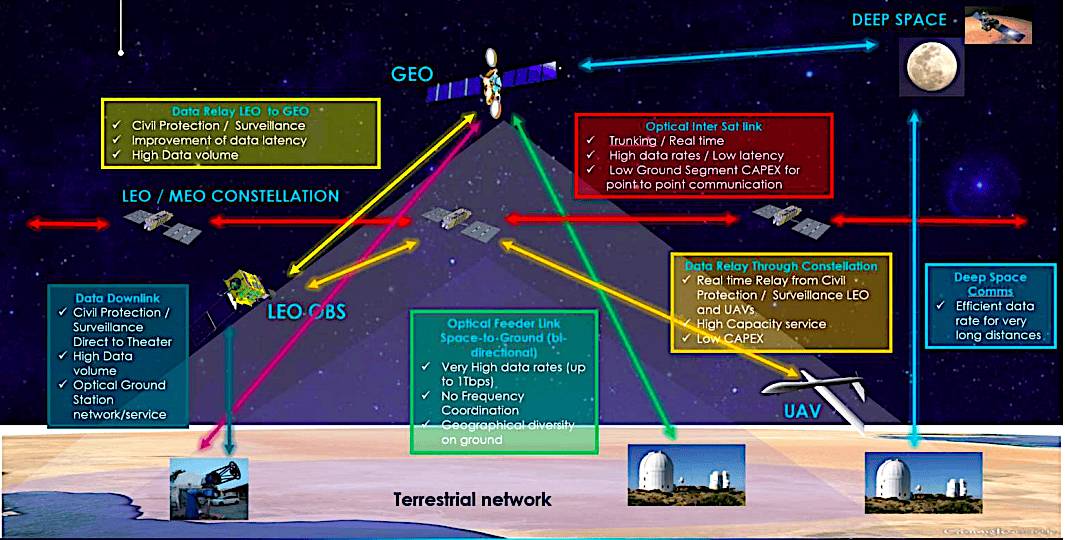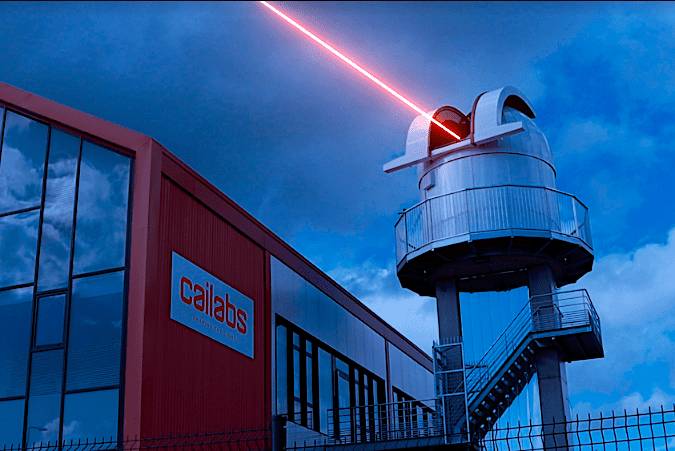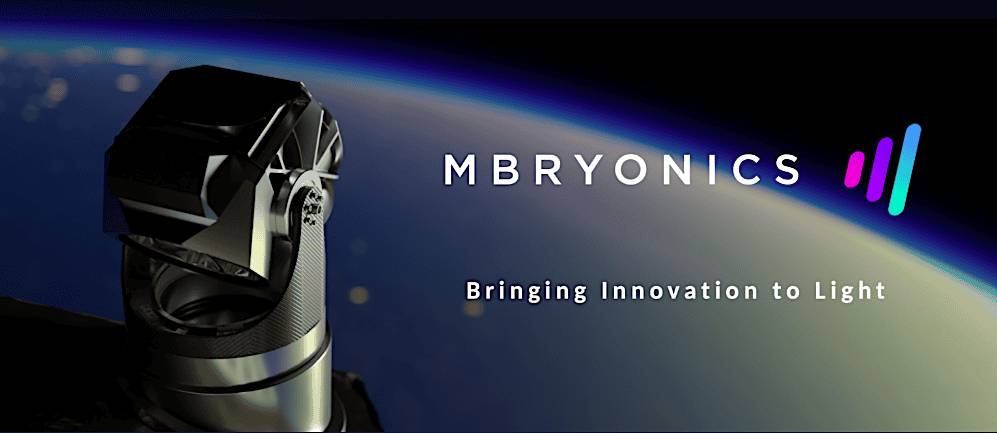 European governments are funding laser communications research projects with diverse applications. (Source: Thales Alenia Space)
European governments are funding laser communications research projects with diverse applications. (Source: Thales Alenia Space)
PARIS — Well over a dozen European companies, using R&D funding from the 22-nation European Space Agency (ESA) and individual national governments, are developing optical laser communications hardware for space-to-space, space-to-ground and ground-to-ground applications.
The efforts, spread out across Europe, are continuing in the shadow of the U.S. Space Development Agency (SDA) missile warning and tracking network, which plans 400 satellites in multiple orbits using multiple providers of optical communications terminals for inter-satellite communications.
To assure that all these satellites can communicate with each other, SDA has developed initial technical standards that its contractors must meet, in addition to proving that they can in fact communicate with competitors’ terminals.
The European effort is not to create a competing standard, but one that advances the state of the art beyond the specific needs of a single network like the SDA’s. New-generation optical communications terminals (OCTs) with size, weight, power and cost adapted to smaller satellites is a principal goal.
 (Source: ESA)
(Source: ESA)
One of the main programs funding the R&D is ESA’s ScyLight, which is part of the agency’s Advanced Research in Telecommunications Systems (Artes) program managed by the Directorate of Connectivity and Secure Communications.
ScyLight received about 200 million euros in financial backing for 2023-2025 at the agency’s late-2022 ministerial council, with possible contributions that would double that amount but were subject to later commitments.
Recent developments under ScyLight and other government-backed optical communications programs:
— OCT provider Tesat Spacecom of Germany and MPB Communications of Canada, which designs optical amplifiers, on April 30 said they had demonstrated at MPB’s Montreal laboratory a 100 Gbps link to a GEO-orbit satellite from a satellite in low Earth orbit (LEO).
The test simulated a distance of 45,000 kilometers and used 40 watts of optical output power at 1536.61 and 1553.33 nm. Canada is a contributing member of ESA.
Tesat said its OCTs on the European Data Relay Service (EDRS), which relay Earth observation data from European Sentinel satellites in LEO to GEO spacecraft for quicker download to users, reach data rates of 1.8 Gbps using 2.2 watts of power.
Tesat said it will use the results from the MPB tests to design its SCOT 135 OCT using MPB’s amplifier. In orbit, it will allow communications at a distance of up to 45,000 kilometers between LEO and GEO satellites, and 80,000 kilometers between two GEO satellites.
 (Source: AAC Hyperion)
(Source: AAC Hyperion)
—Smallsat builder AAC Clyde Space of Scotland, through its AAC Hyperion subsidiary in the Netherlands, is designing a 10-Gbps OCT based on the 1-Gbps CubeCAT V1 demonstrator, now in low Earth orbit as a hosted payload on the Norwegian Norsat-TD technology demonstrator owned by the Norwegian Space Agency.
AAC Clyde is working with the Netherlands Organization for Applied Scientific Research, TNO, and FSO Instruments. The Netherlands Space Office is financing 1.9 million euros ($2 million) of the work through ESA with the industrial consortium paying 1.6 million euros.
The project is scheduled to conclude in late 2026 with the delivery of a 10-Gbps first model.
— The Swedish Space Corp., under contract to ESA with funding from the Swedish National Space Agency, is developing a space-to-ground optical communications network called NODES, or Network of Optical stations for Data Transfer to Earth from Space. The program began in 2022, with its second phase initiated in mid-2023 with a 2.26-million-euro contract.
 (Source: Cailabs)
(Source: Cailabs)
The testing of an initial network is scheduled to occur by 2025 with two optical ground stations. French optical ground station startup Cailabs was hired by SSC to install an optical ground station at an SSC-owned facility in Western Australia.
“Free-space laser communication is a promising future technology which aims to solve the data transfer limitations from space to ground in a secure and power-efficient way,” said SSC’s Hanna Sundberg, the NODES project manager.
SSC in April contracted with Safran Electronics & Defense to supply an optical ground station, to be installed in Chile by the end of this year as part of NODES.
—Airbus and VDL Group in early 2023 entered into a partnership called UltraAir to develop OCTs for aircraft, with development work contributed by TNO and a first flight test scheduled this year.
The UltraAir project envisions links between OCT-equipped satellites in geostationary orbit and military and perhaps commercial aircraft and drones. Airbus operates Europe’s SpaceDataHighway, which speeds delivery of Earth imaging data via laser links from low-orbit Copernicus Sentinel satellites, owned by the European Commission, and satellites in geostationary orbit. ESA’s ScyLight is providing funding for UltraAir.
 (Source: Mbryonics)
(Source: Mbryonics)
—Mbryonics of Ireland in January was contracted by the U.S. Defense Advanced Research Projects Agency (DARPA), to develop an OCT and optical amplifiers as part of the Space-Based Adaptive Communications Node program, known as Space-BACN.
One of the goals of Space-BACN is to develop a small, multi-protocol StarCom OCT that can connect with multiple satellite constellations using different OCT technical standards.
Intel Federal and Arizona State University are developing a reconfigurable modem for the Mbryonics terminal to support up to 100 Gbps links.
Current and future broadband satellite constellation operators SpaceX, Kuiper Government Solutions and Telesat Government Solutions are contributing to the programming standards to assure interoperability.
Mynaric and Tesat of Germany, both of which are building U.S. production plants, are among the OCT providers that have gone through the SDA compatibility testing.
 The optical ground station at the National Observatory of Athens. (Source: NOA)
The optical ground station at the National Observatory of Athens. (Source: NOA)
—Greece’s National Observatory of Athens (NOA) is participating in ScyLight through its Aristarchos telescope, which was selected by ESA as an optical ground station.
In January, Greek satellite operator Hellas Sat and Thales Alenia Space signed an MoU to place an OCT on the Hellas Sat 5 satellite, to operate from 39 degrees east, which would communicate with the NOA ground station and others.
 (Source: Thales Alenia Space)
(Source: Thales Alenia Space)
— Airbus, Safran and Thales Alenia Space are part of a large group of small and large French companies working on the Co-Op program to develop high-throughput OCTs to provide feeder links on geostationary-orbit satellite.
Co-Op is financed by the French governments recovery fund and managed by the French space agency, CNES.
